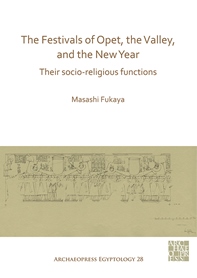 
Религиозните празници, свързани с кръговрата на ежегодните сезонни земеделски дейности са от първостепенно значение за цялото общество на Древен Египет. Три от тях са особено популярни в Тива, столицата на страната през епохата на Новото царство:
- Опет, празнуван през втория месец на Ахет (сезона на разлива на Нил) с тържествена процесия от храма на Амон в Карнак до другия храм в Луксор. Централна тема е възраждането и обновлението, извършва се ритуална ре-коронация на фараона, както и символичен брак на Амон със съпругата му Мут.
- Празникът на Долината (heb nefer en inet) е честван през втория месец на Шему (сезона на жътвата) и е египетският празник на мъртвите. Както и при Опет, церемониалните ладии със статуите на божествата Амон, Мут и Хонсу са изваждани за тържествено шествие. Но този път те обикалят заупокойните светилища на починалите фараони на западния бряг на Нил.
- Древноегипетската Нова година (Wepet-Renpet) или "Отварянето" на годишния цикъл се празнува като първи ден от първия месец, отново през сезона на Ахет. Негово начало дава първото забелязано надигане на водите на реката, за да се разлеят из полята и да ги покрият с плодородна тиня. Централна тема е смъртта и възраждането на Озирис, жалбите на неговата съпруга Изида и неговото чудесно възкресение за нов живот. Фестивалът има и соларни аспекти, свързани с бога на слънцето Ра (Ре), а конкретно в Тива с неговия синкретичен аналог Амон-Ра.
Представената тук монография (защитена като дисертация от Оксфорд) е посветена на социалните функции и характерните особености на тези три празника.
Masashi Fukaya - The Festivals of Opet, the Valley, and the New Year. Their Socio-Religious Functions, Oxford, Archaeopress, 2020 [Archaeopress Egyptology 28]
АЛТЕРНАТИВЕН ЛИНК / ALTERNATIVE LINK:
Masashi Fukaya - The Festivals of Opet, the Valley, and the New Year. Their Socio-Religious Functions, Oxford, Archaeopress, 2020 [Archaeopress Egyptology 28]
АЛТЕРНАТИВЕН ЛИНК / ALTERNATIVE LINK:
Masashi Fukaya - The Festivals of Opet, the Valley, and the New Year. Their Socio-Religious Functions, Oxford, Archaeopress, 2020 [Archaeopress Egyptology 28]
КАТО ДОКТОРСКА ДИСЕРТАЦИЯ / AS A PH.D. THESIS:
Masashi Fukaya - Socio-religious functions of three Theban festivals in the New Kingdom: the festivals of Opet, the Valley, and the New Year, Oxford, Oxford University, 2014
- на английски език, от The Oxford University, формат PDF.Свалянето става с десен бутон (downloading by right button) и Save as..
| 

